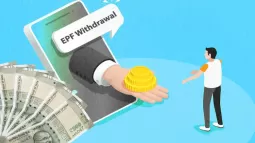
The government has recently made the withdrawal process of EPF money easier. With easier rules, the EPFO has also increased the avenues through which one can withdraw the money. Financial planners always recommend not touching your EPF corpus unless there is an absolute emergency. Usually, both the EPF balance and its interest income are exempt from taxes. But to prevent premature withdrawal, the government levies tax on such withdrawals.
Tax Benefits on EPF Contributions
EPF is an EEE (Exempt-Exempt-Exempt) scheme. It implies that the contribution made, interest accruable, and amount withdrawn at the end are fully exempt from tax, provided certain conditions are met.
- Under the old tax regime, employees can claim a tax deduction of up to ₹1.5 lakh on EPF deposits under Section 80C.
- In the new tax regime, only the employer's contribution is exempt.
In both cases, the balance and maturity amount retain their tax-free status provided the account is held for more than five years.
What Happens If You Withdraw Before Five Years?
If an employee withdraws the EPF balance before completing five years of continuous service on leaving employment, then the withdrawn amount becomes taxable.
At the time of changing jobs, if the employee transfers the EPF balance to the new employer, the combined service period is counted.
- If the total service is less than five years, then income tax is applied to the withdrawn amount.
- The EPF balance has four components:
- Employer's contribution
Employee’s contribution
Interest on the employer's contribution
If the account is closed within a period of five years, the amount attracts tax on both the contribution as well as the interest earned. The amount is added to the individual’s income and taxed as per his income tax slab.
TDS and Exemptions
- TDS of 10% is deducted if the PAN is submitted.
- In case PAN is not furnished, TDS as high as 34.60% is deducted.
No TDS is deducted if:
- The total EPF balance is below ₹50,000, or
- The employee leaves the job due to illness, or
- The employer’s business closes.
Employees can also submit Form 15G or 15H to avoid TDS if their total income is below the taxable limit. Once the account crosses five years, the entire withdrawal is tax-free.
Example of EPF Withdrawal Tax
Suppose Employee A withdraws ₹60,000 after three years of service. His total EPF balance is ₹3 lakh. Since the five-year period is not completed, the withdrawal is taxable.
- If A’s annual income is ₹10 lakh under the new tax regime, the TDS of 10% applies.
- Therefore, ₹6,000 (10% of ₹60,000) will be deducted as tax.
- If the withdrawal is made after five years, there will be no tax deduction.













